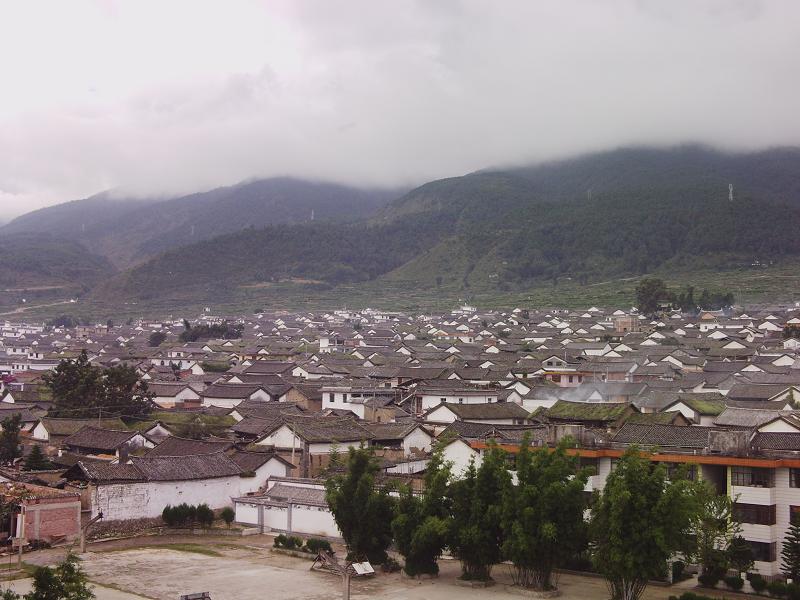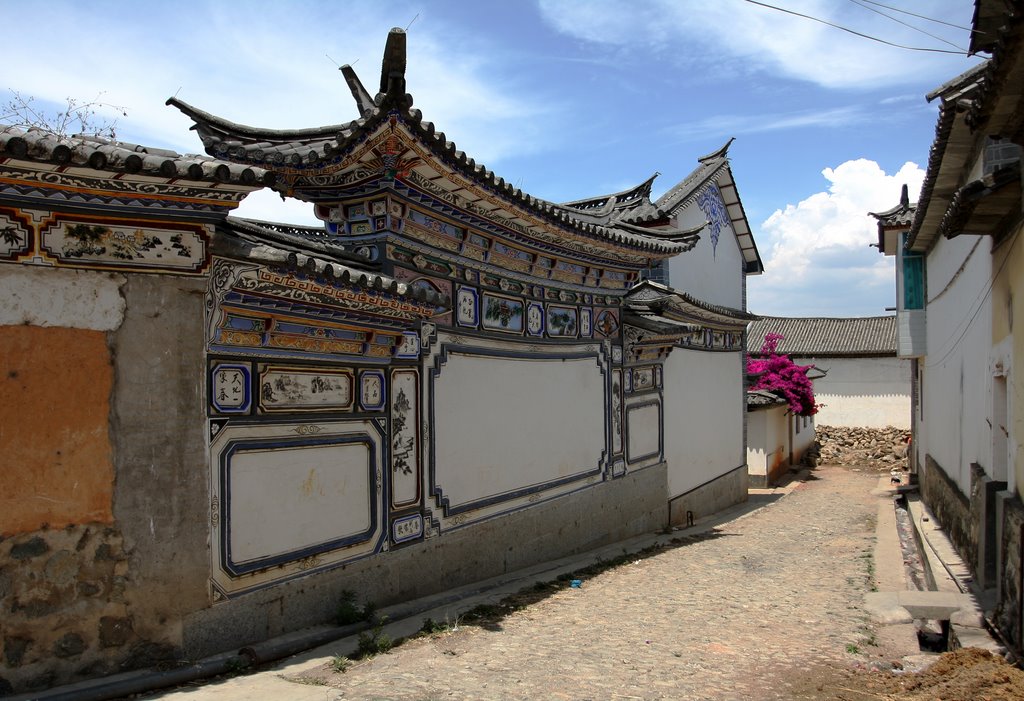
Zhoucheng Town you can see typical houses of Bai people with closed courtyards, consisting of three rooms and a "shining wall." The purpose of the "shining wall" is to reflect light into the houses. Another configuration consists of four rows of houses and five dooryards. For some of the houses, one family has one courtyard; while others have several courtyards for one family. These houses have a square plan. The roof contains two layers of eaves made from green tiles and is designed in the shape of the Chinese character ÈË. There are three to five major rooms which face east or south. They are built with bricks and stones and with a wooden frame that is held together by means of tenons. Sometimes several courtyards are connected with each other and make a single large courtyard. The walls outside are washed with a layer of fine mud and then painted over with a layer of lime.

Bai people pay special attention to the decorations of the shining walls, windows, doors, the frontispiece and the gate-towers. The shining wall is a necessary part of the construction style of one major house, which includes two wing-rooms and courtyards. The shining wall is topped with two layers of flying eaves with up-holding corners. The eaves are made from green tiles. The shining wall stands in front of the main room. It connects the two wing-rooms and the frontispiece so that the three form an enclosed courtyard. The center of the shining wall is brushed with lime, inscribed with characters, or inlaid with marble screens. These are enclosed by frames in the shape of fans, squares and circles.

The objects within the frames are colored by painting with water mill or powder. Most of the doors and windows, especially the lattice door in the living room of the major house, are made from rare lumbers like toons(Mahagony). The doors and windows are carved with patterns like golden chickens jumping onto the branches which are the symbol of being rich and successful, and kylins which are the symbol of being lucky and propitious. The foundation of the gate is built from Haidongqin Stones and has clear edges and corners. On the foundation is the wooden gate tower. The gate tower is carefully carved, and has a precise structure, and flying eaves and up-holding corners.
Bai ethnic Tie-Dying Cloth with Wax (Batik)
Tie-dyeing originated from the central plains area in ancient China over 1,000 years ago. Being one of the locations of this craftsmanship, Zhoucheng Village near Butterfly Spring in Dali Old City is famous as the "Hometown of Bai People's Tie-dyeing Art".
Tie-dyeing is a technology of printing flower patterns on cloth. As the name suggests, the process is divided into "tie" and "dye". Tie refers to making the cloth into certain shapes by pinching, creasing and flanging it according to the flower patterns. They are then sew or tie tightly together to make a bunch of knots. The aim of tying the knots is to dye the untied part while retaining the original color of the knotted parts. The tighter the knots are tied, the better the effect of the color printing will be achieved.
The dyeing process involves first soaking the 'knots' into clear water, followed by immersing them in the dye vat for a period of time before taking them out to dry. After drying, they are again put back in the dye vat and the process is repeated until a satisfactory color is achieved. Once dried, stitches are taken out of the knots and the cloth is smoothen out to reveal that part of the cloth which was sewn and form beautiful flower patterns and the dye crease marks.
Generally speaking, the main colors of the tie-dying process are white and blue, with the white color for the flower patterns and the blue for the background. The contrast of these two colors shows the beauty of simplicity, which reflects the Bai People's peaceful and tolerant minds. The main dye comes from the Ban Lan Gen, the isatis root in English. Cloth dyed with this plant's extract is good to the skin and presents a color of bluish green that is not easily fade.
The tie-dyeing products in Zhoucheng Village are well sought after, both at home and abroad. Do drop by and witness for yourself the process of this historical craftsmanship. Who knows, you will return home with some cheap and beautiful crafted cloths.
Admission Fee:¥0

You will only receive emails that you permitted upon submission and your email address will never be shared with any third parties without your express permission.
